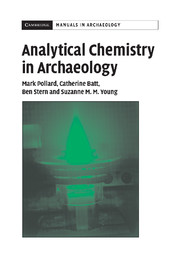Book contents
- Frontmatter
- Contents
- List of figures
- List of tables
- Preface
- PART I THE ROLE OF ANALYTICAL CHEMISTRY IN ARCHAEOLOGY
- PART II THE APPLICATION OF ANALYTICAL CHEMISTRY TO ARCHAEOLOGY
- 3 ELEMENTAL ANALYSIS BY ABSORPTION AND EMISSION SPECTROSCOPIES IN THE VISIBLE AND ULTRAVIOLET
- 4 MOLECULAR ANALYSIS BY ABSORPTION AND RAMAN SPECTROSCOPY
- 5 X-RAY TECHNIQUES AND ELECTRON BEAM MICROANALYSIS
- 6 NEUTRON ACTIVATION ANALYSIS
- 7 CHROMATOGRAPHY
- 8 MASS SPECTROMETRY
- 9 INDUCTIVELY COUPLED PLASMA–MASS SPECTROMETRY (ICP–MS)
- PART III SOME BASIC CHEMISTRY FOR ARCHAEOLOGISTS
- Epilogue
- Appendices
- References
- Index
6 - NEUTRON ACTIVATION ANALYSIS
Published online by Cambridge University Press: 03 May 2010
- Frontmatter
- Contents
- List of figures
- List of tables
- Preface
- PART I THE ROLE OF ANALYTICAL CHEMISTRY IN ARCHAEOLOGY
- PART II THE APPLICATION OF ANALYTICAL CHEMISTRY TO ARCHAEOLOGY
- 3 ELEMENTAL ANALYSIS BY ABSORPTION AND EMISSION SPECTROSCOPIES IN THE VISIBLE AND ULTRAVIOLET
- 4 MOLECULAR ANALYSIS BY ABSORPTION AND RAMAN SPECTROSCOPY
- 5 X-RAY TECHNIQUES AND ELECTRON BEAM MICROANALYSIS
- 6 NEUTRON ACTIVATION ANALYSIS
- 7 CHROMATOGRAPHY
- 8 MASS SPECTROMETRY
- 9 INDUCTIVELY COUPLED PLASMA–MASS SPECTROMETRY (ICP–MS)
- PART III SOME BASIC CHEMISTRY FOR ARCHAEOLOGISTS
- Epilogue
- Appendices
- References
- Index
Summary
Neutron activation analysis (NAA) is an analytical method which allows the determination of the concentration of a large number of inorganic elements in a wide range of archaeological materials. Because it offers bulk analyses of solid samples and is sensitive down to the ppm level (and often below) for a wide range of elements, NAA has been one of the standard methods for multielement analysis since the 1950s. Although it was quickly adopted by geologists for lithic analysis, the technique was pioneered by the archaeological chemistry community – a rare example of the earth sciences adopting a technique from archaeology. It was the standard technique for the determination of trace elements in solid samples across a wide range of sciences until the development of ICP and PIXE in the 1980s. Although it is becoming less common now, as a result of the decreased availability of neutron irradiation, a vast amount of chemical data on a wide variety of archaeological materials has been obtained by this method, and if these results are to be used in future, it is important to understand how they were obtained and how they relate to those from other methods. Detailed accounts of the method can be found in Neff (2000) and Herz and Garrison (1998).
Introduction to nuclear structure and the principles of neutron activation analysis
In essence, NAA involves converting some atoms of the elements within a sample into artificial radioactive isotopes by irradiation with neutrons.
- Type
- Chapter
- Information
- Analytical Chemistry in Archaeology , pp. 123 - 136Publisher: Cambridge University PressPrint publication year: 2007

